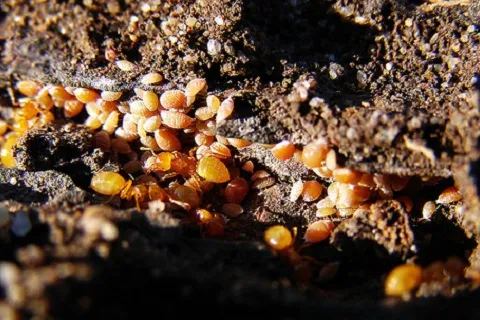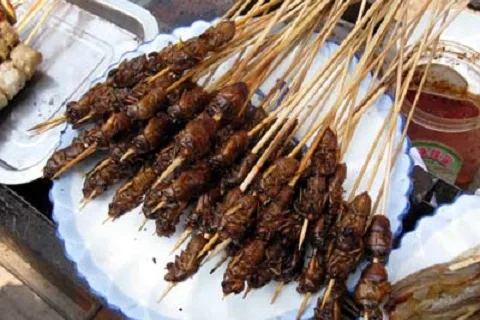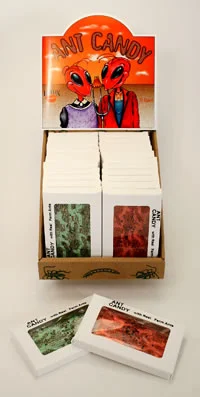Insects are beginning to make an appearance on
menus across the country, while stores like Hotlix in Pismo Beach,
Calif. are putting creepy-crawly sweets on the map.
Insects are actually far more nutritious than other common forms of protein, even fish. For example, 100 grams of top sirloin beef contains about 29 grams of protein in addition to a whopping 21 grams of fat, while 100 grams of grasshopper contains 20 grams of protein and a measly six grams of fat. Big difference!
Insects are actually far more nutritious than other common forms of protein, even fish. For example, 100 grams of top sirloin beef contains about 29 grams of protein in addition to a whopping 21 grams of fat, while 100 grams of grasshopper contains 20 grams of protein and a measly six grams of fat. Big difference!
Many scientists believe that entomophagy ~ insect eating ~ will not
only benefit our health, but also the planet. In an interview with The Guardian, Belgian entomologist Arnold
van Huis says that farming insects emits 10 times less greenhouse gas than
farming livestock.
So why are we so disgusted by the thought of munching on bugs?
Pennsylvania State University professor Manfred Kroger tells National Geographic that our
eating habits are conditioned by our culture. We see insects as the destroyers
of crops and ruin-ers of picnics rather than a food source, while many cultures
~ primarily in Africa, Asia and South America ~ rely on creepy-crawlies as
their main source of protein.
As naturalist, author and "Bug Chef Extraordinaire" David
George Gordon tells the Telegraph, "Insects are the most valuable,
underused and delicious animals in the world."
Here are a few articles and collections of illustrations showing
cultures that have, or are in the process of, hopping on the bug bandwagon.
PART 1:
CUPCAKES MADE FROM INSECTS:
FOOD FOR THOUGHT?
This gives "Let them eat cake!" a whole new meaning!
Photo: Michael Kooren
April 21, 2012
A cupcake made from insects may not sound a scrumptious idea for dessert but researchers at the University of Wageningen in Netherlands believe that insects could provide the best source of protein.
Cakes filled with edible insects in various attractive shapes
were on display at the university on Monday to promote the idea of consuming
insects to meet the needs of a protein-rich diet for a rising population,
Reuters reported.
.
.
A caramelized locust serves as decoration as well as nutrition.
Photo: Michael Kooren
Wielding a grasshopper covered in burned caramel, David Gracer said:
“Insects can
feed the world.
Cows and pigs are the S.U.V.’s; bugs are the bicycles.”
The United Nations Food and Agriculture Organization (UNFAO) says that some insects have as much protein as meat and fish. There are about 1,700 species considered edible for human consumption, including beetles, butterfly, moths, bees, wasp, ants, termites, bugs, grasshoppers and crickets.
In fact, insects are a delicacy in most parts of the world.
“For approximately 2.5 billion people, mainly in Africa, Asia
and Latin America, eating insects is part of their common diets, in a similar
way as eating meat or fish. A number of insect species are considered to be an
exquisite meal such as barbecued palm weevil larvae or roasted termites,” says
FAO.
.
Sugar and spice meets worms and snails.
Photo: Michael Kooren
Edible insects are an important source of protein in Central Africa, while in some countries such as Thailand, demand for edible insects increases with better living standards.
In co-organization with Wageningen University, FAO organized an
expert consultation meeting on "Assessing the Potential of Insects as Food
and Feed in assuring Food Security" in Rome early this year where
nutritional value of insects was discussed extensively.
.
.
Take a bite!
Can the taste of mealybugs really be sweetened?
Photo: Michael Kooren
The scientists said that insects are a good source of essential polyunsaturated fatty acids and are also a significant source of iron, zinc and vitamin A.
.
“This is important in light of the fact that some 2 billion
people are deficient in zinc, 1 billion have iron-deficiency anaemia, and
vitamin A deficiency affects some 250 million people, mainly young children and
pregnant women in developing countries,” FAO said.
However, more research was needed on food hygiene standards and
allergies caused by insects, it added.
An entire cake/cookbook filled with nutritious offerings.
Photo: Michael Kooren
PART 2:
BUGS THAT TASTE LIKE BACON
& OTHER EDIBLE INSECTS
& OTHER EDIBLE INSECTS
Nam prik mang da ~ chili paste made out of these giant water bugs.
YUMMLY
Research from the United Nations Food and Agriculture
Organization shows that bugs are excellent sources of protein and healthier for you and the
environment than steak or pork. Eating these many-legged critters is
promoted by many organizations, including the European Commission, who are offering 4.5 million dollars to the
group that creates the best plan to develop bugs as a popular food.
Even actress turned UN Goodwill Ambassador, Angelina Jolie, says that her children “eat crickets like Doritos.”
If the idea of eating
bugs makes you squeamish, turn away, because here’s our round-up of commonly
eaten bugs, spiders, and insects around the world!
.
.
Consumed in: Southeast Asia
Taste Profile: Believe it or not, these plump, yellow and cream colored sago palm weevil larvae have a taste frequently likened to bacon! In some regions, they’re considered a delicacy for special occasions. They are usually roasted, but they can also be eaten raw. If raw, remove the head prior to consumption, as sago worms have sharp pincers and a tendency to bite.
Consumed in: China
Taste Profile: Scorpions can be consumed fried, roasted, grilled on a stick, or live. Their taste is reportedly fairly bitter and vaguely fishy. If you’re concerned about the venom, the heat used to cook scorpions renders it essentially harmless. Live scorpions are usually eaten with their stingers clipped off and dunked in some kind of wine.
.Consumed in: Cambodia, Venezuela
Taste Profile: Tarantulas are usually cooked and eaten whole: legs, eyes, body, and all. Many people report the taste to be very similar to fried soft-shell crab or shrimp, with a crunchy exterior and somewhat chewy meat. Others claim the taste is more like poultry, with the legs tasting like sparse chicken wings and the body tasting of cold duck.
A traditional snack in Cambodia is fried insects. Anything goes, but big
hairy spiders seem extraordinarily popular. The small village of Skun is renowned for its
deep-fried tarantulas, along with grasshoppers, crickets and beetles.
The place has become so popular that even tour buses stop here now. So
what does a tarantula taste like? The hairy legs are just crispy, but
the big abdomen is full of gooey, yummy guts. Just squeeze and enjoy.
Consumed in: Mexico, Thailand, Cambodia
Taste Profile: Crickets are usually prepared fried, but they can be boiled, sauteed, and roasted. Freshly fried crickets are crispy, and tend to taste like the oil they were cooked in. Some liken the taste and texture of crickets to popcorn or nuts. Many cricket-eaters also recommend removing the legs before consuming.
Consumed in: The Amazon Rainforest
Taste Profile: Lemon ants have an extremely acidic body composition and evolved symbiotically with their host trees; clearings with only a single tree in it are likely to contain lemon ants. Eaten raw, these ants are said to have a crunchy texture, and a tangy lemon flavor.
.Consumed in: All over the world!
Taste Profile: These beetle larvae can be fried, sautéed, boiled, and roasted. They are said to have an extremely mild flavor, which is to say they don’t actually taste like much. Raw, sautéed, or boiled, they are soft and slightly mushy. When fried, they take on the flavor of the oil. Roasted mealworms are slightly crunchy and nutty.
Consumed in: Thailand and other parts of Asia
Taste Profile: Water bugs are actually quite popular in Thai cuisine, often consumed whole, steamed or fried; they are also frequently as extracts for various sauces. Their scent is stunningly reminiscent of sweet, flowery fruits, and their taste is said to be very close to a salted, briny banana or melon.
Consumed in: China, Malaysia, Latin America
Taste Profile: The general consensus appears to be that cicadas have a slight nuttiness reminiscent of almonds or peanut butter, with an asparagus-like aftertaste; others claim that cicadas taste closer to a raw potato drizzled with clam juice. These descriptions are also indicative of its texture: slightly crunchy and juicy and juicy.
Hotlix actually makes entomophagy appear potentially much more appealing
to the Western eye.
PART THREE:
BUGS GO MAINSTREAM
During the springtime, when food is scarce, Ghanaians rely on termites
as their main source of protein. The insects can be roasted, fried or
even used to make bread. Termites are best known for creating these
elaborate homes (and destroying ours).
Bugs are crawling on to menus all across Japan. Some favorites include inago (fried grasshopper), sangi (fried silk moth pupae) and Zaza-mushi (a type of larvae).
Cricket Nibbles. Quite British tea-time looking, old chap.
Love Bug Salad comes with 2 locusts and 3 crickets. Crunchy!
Already, some high-end American eateries have made the jump to serving insects.
Typhoon, a Pan-Asian restaurant at Santa Monica Airport, regularly sells
out of its six-legged appetizers like Singapore-style scorpions with
shrimp toast and “Chambi Ants” ~ potato strings with a sprinkling of the
tiny black picnic pests.
The Netherlands is slowly embracing the idea of eating insects. Johan Van
Dongen (head of the meat department for the Dutch food distributor,
Sligro) is helping to encourage the Dutch to rely on insects (like
crickets) as a source of protein by offering a free taste from a stand
on the sidewalk in the city of 's-Hertogenbosch.
Many Thais love snacking on grasshoppers, crickets and woodworms. The
bugs are seasoned and fried in a wok until crispy, then served to
passers-by at local food markets. Ant eggs, like the ones shown here,
are also popular. Fried bugs are commonly served with beer (like peanuts at a bar).

The silk worm is mostly known for its capability to produce silk. Well, actually it is the silk caterpillar that produces the silk thread when it spins a cocoon around itself. After completion, the silk caterpillar then transforms into a silk worm at which state the cocoon can be harvested for silk production. The cocoons, with silk worms inside, are then boiled so the silk threads can be unwrapped. The finished products are silk and silk worms which locals consider a delicacy. Of all the different insects that can be eaten in Cambodia, silk worms are definitely among the most yummy ones. Try it fried with a bit of salt.
.
In China, roasted larvae from insects like bees are a delicacy served in
high-end restaurants. But on the street, you'll find fully grown
insects like these water bugs roasted or fried and then skewered to make
them easy to eat on the go.
The Chinese snack on a
wide variety of insects, from water bugs boiled and then soaked vinegar to live
scorpions doused in baijiu, a robust
liquor. While Chinese citizens eat all sorts of insects, the country's finer
restaurants tend to serve its delicacies in the larval state. Chinese gourmands
enjoy roasted bee larvae and fried silkworm moth larvae, which are both rich in
nutrients like copper, iron, riboflavin, thiamin and zinc. And when
temperatures begin to drop, the Chinese keep warm with a steaming bowl of ant
soup.
Many of
Australia's indigenous cultures eat insects for protein. The Aborigines
cooked moths in the sand, stirring in hot ashes to help remove the bugs' wings
and the legs. They still collect and eat insects like
honey-pot ants ~ which use their bodies as a portable pantry ~ and witchetty grubs, or large,
wood-eating moth larvae. Roasted witchetty grub has a crispy skin with a
yellowy filling that's said to taste a little like almonds.These bugs ingest food and store it in
their bodies, making them an excellent source of essential nutrients for
bug-eating humans.
Americans generally think of eating bugs as something best reserved for Fear Factor participants.
.
Gently deep frying Joros spider for....
sushi.
Tofu with Praying Mantises
Spring Chicada Larvae Sushi
Deep fried cockroach prepared for...
Sushi.
Eentomophagy ~ the eating of insects.
A variety of sushi.
Waterbeetle broth and noodles.
Cambodian spicy cricket salad.
Man has eaten bugs most of his existence.
The Greeks and the Romans ate them. John the Baptist partook, and yes, locusts
are even kosher. Many cultures in Asia, Africa and the Americas still raise
insects as livestock or gather them through foraging. The United States could
become home to domestic insect farms, employ arthropod husbandry experts and
begin processing insect “mini-livestock” into food ~ breads made from insect
flour as well as whole bugs in various life stages like pupae and larvae. After
all, if Americans love shrimp and lobster, why won’t they eat their terrestrial
cousins? But perhaps only today would there be ice cream lines created of insects. Above, Waterbug ice cream created by Tosci.
.
.
Chocolate dipped crickets.
Chocolate dipped scorpion.
Grocery store style.
Let us never forget this great American tradition: In Mexico, bugs are eaten in a variety of ways: fried, buttered or even
dipped in chocolate. But perhaps the most renowned method is to drink
them. Mezcal, a Mexican liquor (sometimes confused with tequila), is often served with a worm ready for swallowing.
Hungry for more?:
Hungry for more?:
Clear
hard candy filled with real ants, packaged to look like a miniature
ant farm...
Simulated butterfly candy with real insects and edible flowers inside.








































 KK
KK

No comments:
Post a Comment
If your comment is not posted, it was deemed offensive.